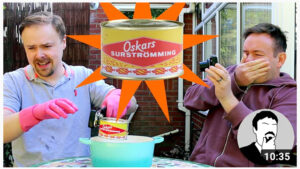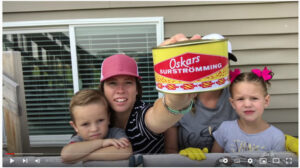Oh my god, what is that foul and pungent smell? Is there a problem with the plumbing?
Wait, give it a chance and smell it closer, deeper. Mmm … there, at the very end of your olfactory sensory neurons, it starts smelling rich, fermented, even mouth-watering.
The taste receptors in your mouth activate and saliva flows as you get hungry, preparing all the necessary ingredients to accompany this northern Swedish delicacy. Yes, you guessed right, it’s the Baltic herring known as surströmming.
Loved by many and hated by others, this dish is an acquired taste. A Swedish tradition or part of the national identity, as some claim, surströmming is mostly consumed in the north on the third Thursday of August aka ”surströmming day” (Surströmmingsskiva), and throughout early September. The old-style way of preparing it is known as “Surströmmingsklämma”, where the tunnbröd is used to make a sandwich together with butter, diced onions and sliced potatoes.
So, what is the history behind this infamous fish?
A discovery by Adam Boethius of Lund University in 2015 in Blenkinge, in the south, revealed that fermented fish has been produced in Sweden since the Mesolithic era (which started in about 9,200 and lasted until 4,300 years ago).
Boethius’s find indicates that herring were fermented on an industrial scale (at least 60,000 tons at the site outside Sölvesborg in Blekinge), and that they were preserved without salt or storage jars and were acidified using pine bark, wrapped in seal fat and wild boar skin before being buried in a pit. And that surströmming was a staple food of southern Swedes for millennia.
High salt prices in Sweden historically have continued to favour the consumption of this sour fish over salted fish as it was cheaper to make a weaker brine.
’GOOD FOR YOUR STOMACH!’
The original process required a cold climate to help preserve the fish until the fermentation was complete and it was dug up for consumption. It doesn’t sound very appealing at all but, eventually, thanks to modern canning methods, the fermented herring has entered the modern age.
The canning procedure, introduced in the 1800s, allowed the product to be sold in shops and stored at home, whereas, before, the final stage would have been storage in large wooden barrels and smaller, one-litre kegs.
Nowadays, surströmming is prepared when the herring is caught in April and May and has not yet fattened. Submerged into a strong brine for about 20 hours to draw out the blood, it is then gutted and the head removed.
The fermentation process takes a few weeks and will depend on a lactic acid enzyme in the spine that is activated by the right conditions. Finally, the fish is canned and distributed for all to enjoy.
Although fermented foods are known to be good for your stomach, and many cultures have their signature fermented cuisine, most of them pale in comparison with surströmming, which has gained notoriety as “one of the world’s stinkiest foods”.
Videos of people (above) trying to eat surströmming have often gone viral on social media as people show off their bravery by eating directly from the can without following the normal preparation methods, only to end up gagging, swearing, holding their noses, or even throwing up.
This is all a shock to the connoisseur, since surströmming is not meant to be eaten straight from the can.The ritual, of shredding the flesh, removing the bones, and discarding the roe, is taken seriously and definitely helps improve the culinary experience.
Skellefteå resident, Yvonne Wahlberg (above), enjoys eating surströmming every year and delights in introducing people to this new and special taste. 
Yvonne looks back on one memorable event. “Once, we had a surströmming party with 20 students and teachers from different countries (Colombia, Venezuela, Netherlands, Iran, India, China and Brazil). Most of them loved it.”
’I DIDN’T LIKE IT AT FIRST’
Yvonne also explains that you must learn how to eat surströmming.
“When I first tried it, I didn’t like it either. It’s the ritual, the preparation of all the ingredients that makes it so delicious and fun. I really, really like to eat it, but no more than three to four times a year.” Having grown up in southern Sweden, Yvonne didn’t try surströmming until moving to Skelleteå as a teenager. ”I started with my friends when I was 15-17 years old. We would have a party and eat surströmming and drink snaps. I think it actually started with the snaps,” she laughs. Her sons like to eat it, too, and they keep the tradition going with her grandchildren.
Yvonne explains that, unfortunately, the herring is disappearing because of climate change, “It’s very sad that you can’t find as many herring in the sea as before.”
HOW TO EAT IT

If you live in a flat, putting the can in the freezer for a few minutes will reduce the smell. It is a good idea to open the can directly in the kitchen sink. If you tilt the can 45 degrees and use the can opener at the top, where the pocket of air will be, it will prevent splashing.
The running water will quickly wash the liquid away, and you can rinse the fish before plating up. If you buy a can of whole fish, you need to gut them, take the spine out and remove the skin (optional), before dividing each fish into two fillets.
You can also buy surströmming fillets, so you don’t need to spend so much time preparing the fish.
Our serving suggestion:
1 can of surströmming
1 packet of tunnbröd
1 bag of almond potatoes (boiled)
1-2 red or white onions (diced)
3-4 tomatoes (sliced)
1 bunch of chives (chopped)
1 bunch of dill
Sour cream or crème fraiche
Some people like to add Västerbotten cheese to balance the flavour of the fish.
Start by taking a piece of tunnbröd, and buttering it. Slice some potatoes and put them on top. Follow up with one or two surströmming fillets, add some tomatoes, red onions, a splash of sour cream and, finally, add the dill and chives as topping. Get your shot glass ready with really cold snaps and be ready to “skål” your way to a new experience.















